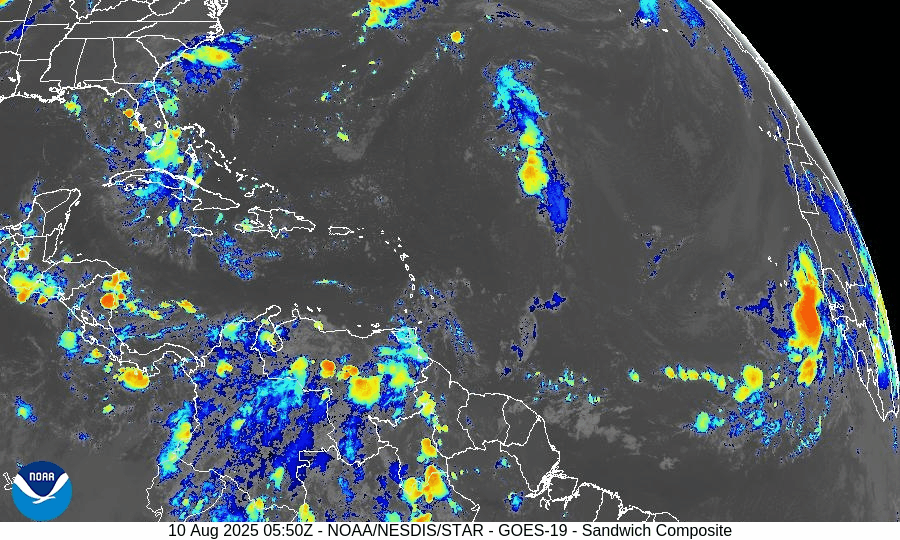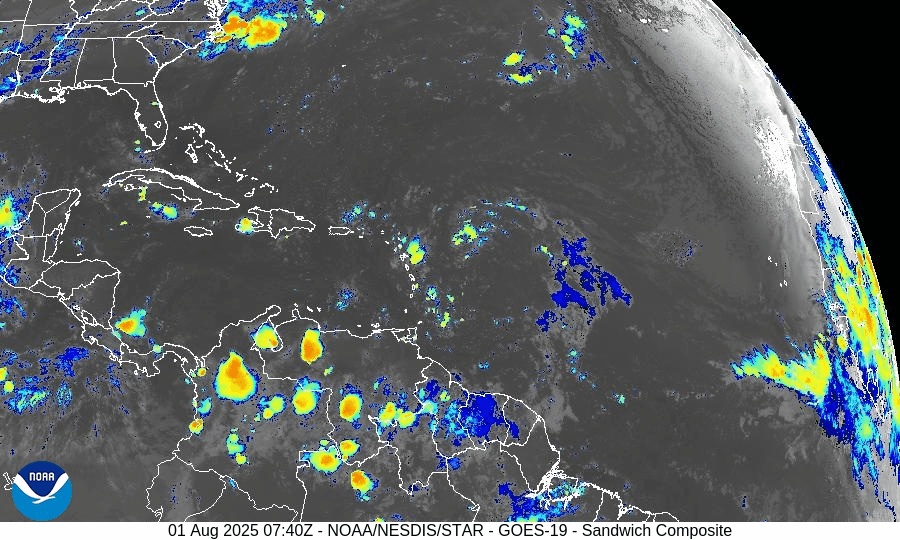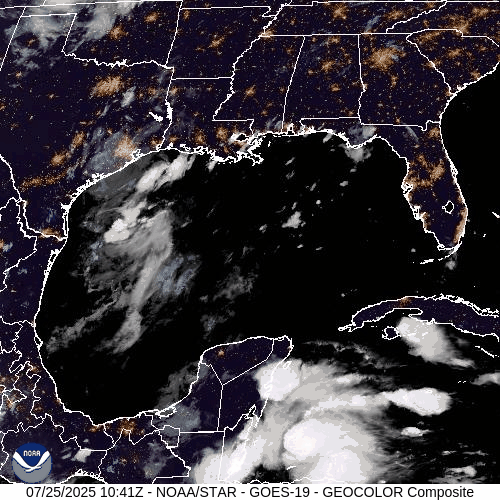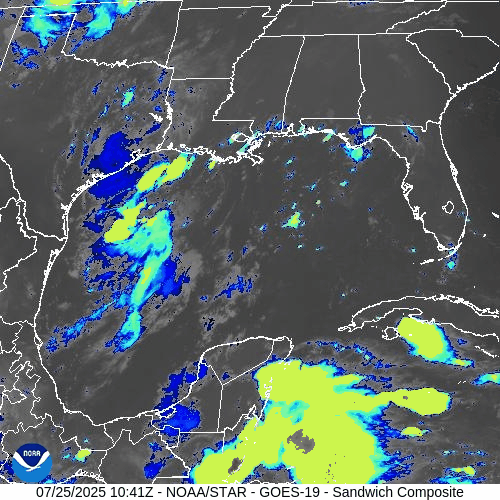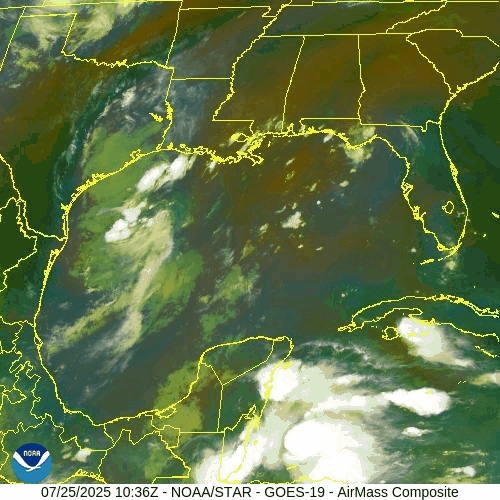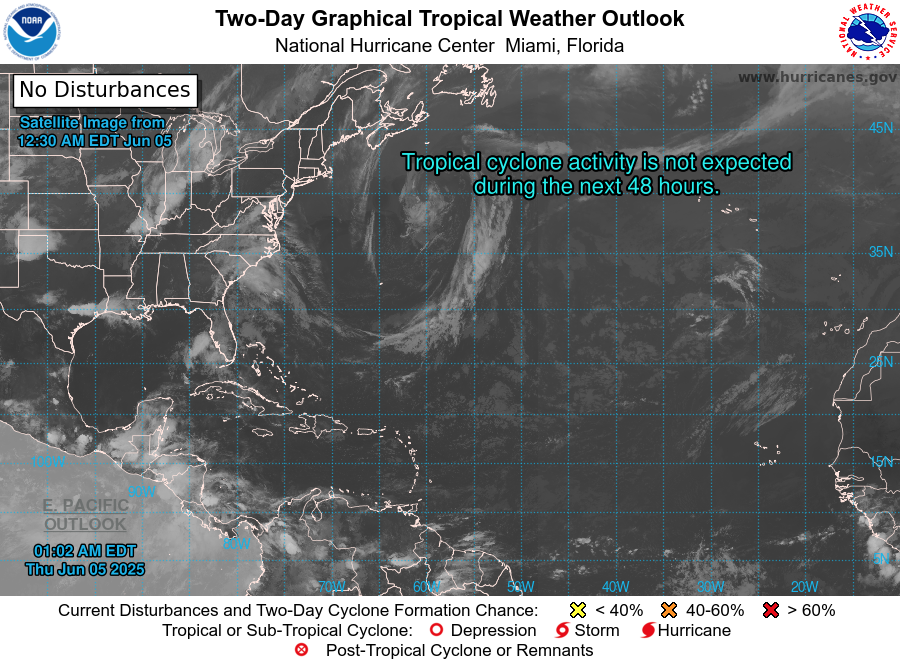Atlantic Hurricane Outlook – August 10, 2025: Multiple tropical waves crossing the Atlantic; development chances gaining
Multiple tropical waves are moving across the Atlantic today, but Saharan dust, wind shear, and dry air are keeping development chances low. Warm ocean temperatures could allow for changes later this week.
Atlantic Basin Overview
TLDR Version; Jump Here
As of this morning, no named tropical cyclones are active in the Atlantic. Several tropical waves are traveling westward across the Main Development Region (MDR), but most are struggling with environmental challenges that limit development. Sea surface temperatures are amply warm, so these waves will continue to be monitored as they move toward more favorable conditions later this week.
Key Systems We’re Watching
Central Atlantic Tropical Wave (~40°W):
Moving west at 10–15 knots with scattered convection. Organization remains limited due to dry air and moderate wind shear. Low chance of development over the next 7 days.Eastern Atlantic Tropical Wave (~23°W, off Africa):
Recently emerged from the continent with convection along its southern flank. Battling Saharan dust and dry air, keeping development chances low in the near term, potentially gaining strength in next 7-days.Monsoon Trough Low (~08N44W):
Embedded within the monsoon trough, sparking intermittent thunderstorm activity. No immediate signs of organized development.
GOES-19 - Sector view: Tropical Atlantic
GFS Future 8/18/25 - Curving NE off Coast of US
Euro Future 8/20/25 - Curving NE off Coast of US
Environmental Conditions
Sea Surface Temperatures (SSTs):
MDR running 28–29.5°C (82–85°F), with 29–31°C (84–88°F) in the Caribbean and Gulf of Mexico—plenty of fuel for storms if other conditions improve.Wind Shear:
Moderate to high shear in the central Atlantic is tilting storm structures and preventing vertical stacking of thunderstorms, slowing development.Moisture:
Humidity is increasing in the western tropical Atlantic, but dry air still lingers across much of the MDR.Saharan Air Layer (SAL):
Dry, dusty air extends across the eastern and central MDR, suppressing convection and capping short-term development potential.
Regional Outlooks
Gulf of Mexico:
No organized tropical disturbances. Typical summer thunderstorms will continue along coastal areas.Caribbean Sea:
Fresh trades persist in the south-central basin with occasional showers. No organized systems.U.S. Southeast & Florida:
Hot and humid with scattered sea-breeze thunderstorms each afternoon. No tropical threats expected today.
GOES-19 - Sector view: Gulf
GOES-19 - Sector view: Caribbean
Looking Ahead (5–10 Days)
The “wave train” from Africa will continue. As SAL weakens and shear pockets relax later this week, one of these waves could encounter a more favorable environment, especially in the central/western MDR.
Prep Reminder
This quiet stretch is the ideal time to review your hurricane plan, restock supplies, and confirm your household communication strategy.
TL;DR – August 10, 2025:
No active storms; several tropical waves in the MDR.
Development chances remain low in the short term due to SAL, wind shear, and patchy moisture.
Warm SSTs mean conditions could turn more favorable later this week. (Chance 70% Dev in next 7-days)
No tropical impacts expected for the U.S. today.
Atlantic Hurricane Outlook – August 1, 2025: Quiet Tropics, Conditions Gradually Shifting
No storms expected as August begins, but multiple tropical waves are being tracked. Conditions are evolving and a shift toward higher hurricane activity is expected in the coming weeks.
*Those who like data, continue reading. Those it prefer the quick version, jump to the TL;DR here.
As we enter August—historically the onset of peak Atlantic hurricane activity—there are no active tropical cyclones and no development expected over the next seven days. However, several tropical waves are moving westward, and environmental conditions are slowly transitioning toward a more favorable pattern for storm formation later in the month.
Atlantic Basin Overview
According to the 8:00 AM EDT Tropical Weather Outlook (TWO) from the National Hurricane Center:
Tropical cyclone formation is not expected during the next 7 days WikipediaNational Hurricane Center
While no waves are currently listed as having development potential, multiple waves are traversing the eastern Atlantic.
Tropical Waves & Deep Tropics
Forecast models highlight several waves across the Atlantic, though none show organization yet:
A wave near 43–50°W, moving west at ~10–15 kt, producing scattered convection.
Another wave near 30°W, just moving off Africa, with intermittent thunderstorms.
These waves will be closely monitored as they enter warmer waters and encounter decreasing wind shear.
Environmental Conditions Snapshot
Sea Surface Temperatures (SSTs):
Gulf of Mexico & Caribbean: 29–31 °C (84–88 °F), sustaining high energy potential.
MDR: Slightly above-average values, but cooling compared to June trends .
Wind Shear:
Elevated across the Caribbean and central Atlantic—a limiting factor in early July—but gradual easing is forecast by mid-August.
Saharan Air Layer (SAL):
Persistent dry air suppressing convection across most of the MDR, but expected to weaken soon.
Atmospheric Moisture:
Enhanced moisture is slowly building in the western Atlantic, improving potential for organized convection.
Gulf of America (Mexico) & Caribbean Conditions
No disturbances are being tracked.
A dominant high-pressure ridge produces stable flow across both basins.
Offshore marine conditions remain calm, with scattered showers typical for this time of year.
Gulf of America (Mexico)
Caribbean
Florida Forecast
Highs: Low 90s °F, sticky and humid.
Precipitation: Scattered afternoon storms driven by afternoon heating and sea breeze convergence.
Winds: Light and variable inland, shifting southeast near the coast.
Rain forecast visualization courtesy of Windy.com
Prep Tip of the Day: Bookmark Tropical Outlook Sources
With activity still weeks away:
Confirm you can receive alerts from the National Hurricane Center.
Bookmark reliable sources such as Cat5Prep.com.
Ensure household members know where your hurricane documents and kits are stored.
Outlook
No cyclone formation is expected this week, but climatology and model trends suggest early-to-mid August could mark the beginning of increased tropical activity. The bulk of Atlantic season activity historically occurs after August 1, with the first hurricane typically forming around August 11.
TL;DR – August 1, 2025 Atlantic Forecast
No active or developing storms in the basin.
Several tropical waves tracked, none organized.
SSTs are warm; shear and SAL still suppressive.
A shift toward higher activity likely in early August.
Today is a good day to finalize hurricane plans and stay alert.
Atlantic Hurricane Outlook – July 27, 2025: Calm Conditions Continue Despite Active Waves
The tropics stay quiet on July 27, 2025, but tropical waves in the deep Atlantic are being closely monitored. No development is expected in the next 7 days, but changes could come as we approach August.
*Those who like data, continue reading. Those it prefer the quick version, jump to the TL;DR here.
The Atlantic basin remains free of named storms this morning, with no tropical cyclone formation expected over the next seven days. However, meteorologists are closely monitoring several tropical waves in the deep eastern Atlantic that could signal a developing pattern as we head into August.
Atlantic Basin: Quiet—but Watchful
No active tropical cyclones in the Atlantic basin.
The National Hurricane Center (NHC) reports that no tropical development is expected over the next 7 days.
Tropical waves in the eastern and central Atlantic continue to be monitored for organization.
Gulf of Mexico and Caribbean: No Significant Activity
No low-pressure disturbances currently under watch.
Conditions in the Gulf remain stable, with typical afternoon thunderstorms but no signs of tropical development.
Lower Caribbean waters remain under fresh easterly trade winds, with rather isolated convection near Central America.
Tropical Waves: Deep Atlantic Features to Monitor
According to the NHC’s Tropical Weather Discussion:
A tropical wave near 27°W (south of 17°N) is moving west at ~10 kt, with scattered moderate convection noted between 5°N and 9°N.
A stronger wave near 54°W (south of 22°N) is moving west at 15–20 kt, with scattered convection between 5°N–23°N.
An area of low pressure embedded in the monsoon trough near 8°N44°W is also aiding scattered convection but remains disorganized.
None of these systems currently have the structure required for classification, but they inhabit regions where sea surface temperatures and wind shear may soon become more conducive to development.
Environmental Conditions Snapshot
The Saharan Air Layer (SAL) remains strong across the eastern Atlantic, suppressing mid-level moisture and convection.
Wind shear in the central Atlantic remains moderate to high, limiting tropical organization—though forecasts suggest a gradual reduction heading into early August.
Sea surface temperatures across the Main Development Region (MDR) remain above average, providing energy should conditions improve later this month.
Dust & SAL data from Windy.com
Florida Forecast
Highs around 90 °F with coastal humidity making it feel hotter.
Rain Chance: 40–50% for scattered afternoon thunderstorms driven by sea breeze convergence.
Winds: Light and variable, shifting to southeasterly in the afternoon.
No tropical impacts expected today.
Rain forecast visualization courtesy of Windy.com
Prep Tip of the Day: Check Your Weather Apps and Alerts
While the tropics are quiet, confirming your local alert settings and weather tool readiness can make all the difference:
Enable push notifications for National Hurricane Center advisories.
Confirm alert registration with your county emergency system.
Test weather apps and bookmarks on all household phones and devices.
Looking Ahead: August May Bring Change
Though today’s conditions remain tranquil, the presence of several tropical waves moving into warmer Atlantic waters—combined with weakening Saharan dust and decreasing wind shear—suggest a gradual shift toward a more active setup. Historically, the first week of August often kicks off heightened tropical activity.
Stay alert. Stay ready. Daily Atlantic updates from Cat5Prep.com.
TL;DR
Atlantic Hurricane Forecast for July 27, 2025
No tropical storms are expected this week — the Atlantic remains quiet.
Three tropical waves are being monitored across the basin. None are showing strong signs of development yet.
Sea surface temperatures are hot and rising — especially in the Gulf and Caribbean — setting the stage for activity in August.
Wind shear and dry air (Saharan dust) continue to limit development for now.
Florida and the Gulf Coast: Typical summer weather—hot, humid, and scattered afternoon storms.
Prep Tip: Now is the time to stock up on essentials and finalize your hurricane communication plan.
No immediate threats, but stay alert. The quiet won’t last forever.
Atlantic Hurricane Outlook – July 25, 2025: Gulf Disturbance Monitored, Basin Remains Broadly Quiet
Stay updated on the Atlantic hurricane season: July 25, 2025. A weak Gulf disturbance brings rain to Texas & Louisiana, while the broader Atlantic remains quiet with no immediate threats. Prepare now for August!
As we close out the final week of July, the Atlantic basin remains broadly quiet. The only area of interest remains a weak disturbance in the western Gulf of Mexico, which continues to produce showers but shows little sign of organizing. Elsewhere, several tropical waves are making their westward march across the Atlantic, but no significant development is expected in the short term.
Gulf of Mexico: Weak Trough Brings Rain, Low Development Risk
A surface trough remains draped across the western Gulf of Mexico, generating scattered showers and isolated thunderstorms—particularly offshore of Texas and Louisiana.
The disturbance remains disorganized, with no closed low-level circulation.
Wind shear and surrounding dry air continue to limit development potential.
The National Hurricane Center (NHC) gives this system a low (10%) chance of development over the next 7 days.
However, heavy downpours and localized flooding remain possible across parts of coastal Texas and southwestern Louisiana today.
This weak trough is expected to gradually dissipate as it moves slowly westward.
Atlantic Basin: Multiple Waves, No Immediate Threats
The broader Atlantic remains seasonally active with several tropical waves but no current threats:
Tropical wave near 50°W: Moving westward with scattered convection; not showing signs of organization.
New wave near 23°W, just off the coast of Africa: Tracking westward along the monsoon trough with convection near its southern flank.
A weak low embedded in the monsoon trough near 08N44W is helping spark convection but lacks any closed circulation.
None of these features show signs of imminent development, though they will be monitored closely in the coming days.
NOAA/NESDIS/STAR – GOES-19 Air Mass Composite – July 25, 2025
Sea Surface Temperatures & Atmospheric Conditions
Sea Surface Temperatures (SSTs) across the Gulf of Mexico and Main Development Region (MDR) remain well above average, supplying ample fuel for tropical development later this season.
Wind Shear remains moderate in the central and western Atlantic, limiting near-term organization.
The Saharan Air Layer (SAL) continues to suppress convection across much of the eastern Atlantic, especially north of the MDR.
Dust & SAL data from Windy.com
Florida Forecast: Typical Summer Pattern
Today’s outlook for Central Florida includes:
Highs in the low 90s°F (32–34°C)
Humidity: High, with heat indices nearing the upper 90s
Rain Chances: Scattered afternoon thunderstorms, driven by sea breeze and daytime heating
Winds: Light and variable, shifting southeast in the afternoon
No tropical impacts are expected for Florida at this time.
Radar imagery courtesy of Windy.com
Prep Tip of the Day: Review Your Evacuation Routes
Use this quiet period to refresh your storm plan:
Know your local evacuation zones
Map out primary and alternate routes
Keep a printed copy in your emergency kit in case power or cell service goes down
Share your plan with family or household members
Looking Ahead: Tropics Likely to Awaken in August
While the Atlantic basin remains quiet for now, the underlying signals—record SSTs, westward-moving waves, and easing shear—suggest a more favorable environment could emerge as we enter August. Stay alert, stay prepared, and keep checking in for daily updates.
Atlantic Hurricane Outlook – July 18, 2025: Tropics Quiet, But Gulf Moisture Persists
The Atlantic remains free of tropical storms today, but rising ocean heat and evolving atmospheric patterns point to potential development in the coming weeks. Stay prepared with Cat5Prep's daily hurricane outlook.
The Atlantic basin remains relatively quiet as we enter the weekend, with no active tropical cyclones or immediate threats on the map. However, lingering moisture from a weak low in the Gulf of Mexico continues to impact parts of the Southeast with enhanced rain chances. Meanwhile, environmental signals are gradually shifting toward favorability as we move closer to the climatological ramp-up in late July.
Atlantic Basin: Still Quiet, But Watchful
As of this morning’s update from the National Hurricane Center (NHC):
No active tropical cyclones
No named systems or advisories
No tropical development expected over the next 7 days
The basin remains in a holding pattern—but that may change in the weeks ahead.
Satellite imagery courtesy of Windy.com
Sea Surface Temperatures: Running Hot
Ocean heat content continues to build across key development zones:
Gulf of Mexico: Sea surface temperatures (SSTs) remain in the mid-to-upper 80s°F (29–31°C), well above average.
Western Caribbean: Waters continue to warm, supporting deep convection.
Main Development Region (MDR): SSTs between Africa and the Caribbean are approaching thresholds that historically support long-track hurricanes.
These conditions set the stage for rapid intensification when tropical systems do form.
Sea Surface Temperature data courtesy of Windy.com
Wind Shear and Atmospheric Moisture: Becoming More Conducive
While upper-level wind shear remains moderate in parts of the Caribbean and central Atlantic, it is gradually weakening—especially closer to the Gulf. Atmospheric moisture continues to increase:
Mid-level moisture is supporting thunderstorm development
Reduced shear and rising instability create a more supportive environment for potential tropical waves
This combination is worth monitoring as we approach the latter half of July.
Relative Humidity (ECMWF) data courtesy of Windy.com
Wind Shear Courtesy of https://tropic.ssec.wisc.edu/
Saharan Air Layer: A Temporary Shield
Dry air and dust from the Saharan Air Layer (SAL) remain active over the eastern Atlantic:
SAL suppresses convection by drying out the lower atmosphere
It also enhances wind shear, limiting vertical storm growth
This protective layer typically weakens in August
While it currently limits tropical wave development off Africa, its influence is expected to wane soon.
Saharan Air Layer (Dust) data courtesy of Windy.com
Gulf Moisture: Lingering Showers, Low Development Risk
A broad area of low pressure and enhanced moisture remains over the northern Gulf of Mexico:
Development chances remain very low
The system is disorganized, with no surface circulation
Still, heavy rain and localized flooding are possible today along the Gulf Coast, particularly in southern Alabama, the Florida Panhandle, and southeastern Louisiana
This disturbance is more of a rainmaker than a tropical threat but illustrates how even weak lows can impact coastal regions.
Rainfall forecast (ECMWF) courtesy of Windy.com
Florida Forecast: Humid and Storm-Prone
Expect classic July conditions across the state:
North Florida: Highs in the low 90s, partly cloudy, isolated afternoon storms
Central Florida: Around 91°F, muggy, with widespread PM storms
South Florida: Mid-to-upper 80s, very humid, storms possible after 2 PM
Local flooding is possible in poor drainage areas due to repeated rounds of heavy showers.
Thunderstorm forecast (ECMWF) courtesy of Windy.com
Prep Tip of the Day: Review Evacuation Zones
Now is the time to double-check your local evacuation zone and routes:
Know whether you're in a surge or flood-prone area
Identify multiple exit routes in case primary roads are closed
Plan ahead for pets, medication, and transportation
Being familiar with your zone before a storm is one of the best preparedness steps you can take.
Looking Ahead: A Quiet Stretch, But a Shift Is Coming
While the tropics are calm for now, the combination of warming waters, weakening wind shear, and deepening atmospheric moisture signals that a transition to a more active pattern is coming.
Expect activity to increase in late July into early August, as the historical ramp-up in hurricane season begins.
Check back tomorrow for the next update from Cat5Prep.com.
Atlantic Hurricane Outlook – June 18, 2025: Tropics Stay Quiet as Pacific Storms Steer Focus
The Atlantic remains storm-free on June 18, with no tropical systems expected over the next 7 days. But warming ocean temps and an active Pacific raise long-range concerns.
The Atlantic basin remains calm today, with no active tropical cyclones and no systems being monitored for development in the National Hurricane Center’s latest 2 AM EDT outlook. This early-season quiet continues, but shifting global patterns—warm oceans, dust, and Pacific activity—are fueling a cautious watchfulness.
Atlantic Basin: Clear, But Keep Watching
No Atlantic systems are active, and the seven-day forecast shows no tropical development expected this week . While mid-June calm is common, meteorologists note stronger global volatility due to cross-basin interactions and shifting climate signals.
Satellite view via Windy.com
Pacific Spotlight: Tropical Storm Erick on the Rise
Wind Speed Probability Tropical Storm Erick
All eyes are on the Eastern Pacific, where Tropical Storm Erick is rapidly strengthening—forecast to become the season’s first Pacific hurricane. Though Erick poses no threat to U.S. shores, it demonstrates the early-season dynamism that Atlantic may encounter soon.
Wind Gust Accumulation Forecast (ECMWF) via Windy.com
Sea Surface Temperatures: Heat Builds Beneath the Calm
Gulf & Western Caribbean: SSTs remain well above average (84–88 °F), providing potential fuel.
Main Development Region (MDR): Water temperatures are warming and trending warmer than early June norms, laying a foundation for development later in the season.
Sea Surface Temperature via Windy.com
Saharan Dust & Atmospheric Inhibitors
Wind Shear Courtesy of https://tropic.ssec.wisc.edu/
A large plume of Saharan dust continues to stretch across the Atlantic and into the Caribbean and Southeast U.S., suppressing tropical formation and degrading air quality.
This dust layer, combined with moderate wind shear, continues to inhibit tropical systems.
Saharan Air Layer (Dust) via Windy.com
Thunderstorm Activity: Summer Rhythm
Florida & Southeast U.S.: Expect standard afternoon thunderstorms, born from daytime heating—not tropical phenomena.
Caribbean & Atlantic: Skies remain clear, with no clusters or organic storms forming.
Air Quality Alert: Sensitive groups should note haze and dust over the Southeast.
Thunderstorm Forecast (ECMWF) via Windy.com
Florida Forecast (June 18)
Highs: Upper 80s to low 90s°F (31–33 °C)
Humidity: High, with muggy conditions
Rain: Isolated to scattered afternoon storms
Visibility: Reduced by dust haze in some regions
Winds: Light, stronger near storms
Rainfall Forecast (ECMWF) via Windy.com
Prep Tip of the Day: Monitor Dust and Air Quality
Minimize outdoor exposure if you’re sensitive to dust
Clean or replace filters in HVAC systems
Keep monitoring dust levels through local air-quality alerts
Continue hurricane planning while skies are calm
Looking Ahead: Still Quiet, But Global Trends Are Stirring
No Atlantic storms are expected this week. However:
SSTs remain elevated
Wind shear may ease gradually
Saharan dust may shift or thin
Eastern Pacific activity—like Erick—offers insight into potential future Atlantic behavior
Use this calm period to prepare. Tomorrow could bring the first tropical ripple, so stay connected to Cat5Prep for ongoing updates.
Atlantic Hurricane Outlook – June 17, 2025: Tropics Remain Quiet Despite Peak Heat
The Atlantic basin remains calm with no tropical storms in sight, despite record ocean heat and widespread Saharan dust. Forecasters continue monitoring subtle environmental shifts that could drive activity later this month.
The Atlantic basin remains clear today, with no active tropical cyclones and no tropical development expected over the next seven days, according to the National Hurricane Center’s 2 AM EDT outlook. Despite intense heating of sea surfaces, climatic factors are currently suppressing system formation.
Atlantic Basin: Calm, But Conditions Are Charged
No tropical cyclones or disturbances are being monitored. The Atlantic basin is experiencing what experts are calling an “unusual lull”—something highlighted recently by the Houston Chronicle, which also noted the ongoing Saharan dust presence suppressing early-season activity.
Satellite view via Windy.com
Sea Surface Temperatures: Fuel Ripe, But Storms Dormant
Gulf of America (Mexico) & Western Caribbean: Waters are hovering near 2°F above average, reaching 84–88°F, akin to early June 2024—an impressively warm baseline for storm development.
Main Development Region (MDR): Also experiencing above-average SSTs, laying the groundwork for future storm growth, though not yet fueling storms.
Sea Surface Temperature via Windy.com
Atmospheric Dynamics: Still Holding Back Storms
Wind Shear Courtesy of https://tropic.ssec.wisc.edu/
Wind Shear: Remains moderate to high, hindering storm organization across key regions.
Mid-Level Moisture: Slowly increasing, which may support thunderstorm development—but conditions remain insufficient for cyclones.
Saharan Dust Layer: A steady plume of Saharan air continues to suppress convection, reinforcing atmospheric stability across the Atlantic.
Saharan Air Layer (Dust) via Windy.com
Thunderstorm Activity: Local Showers Only
Florida and much of the Southeast will experience typical midday and afternoon thunderstorms driven by summer heat—not tropical systems. The Caribbean and Atlantic remain clear, with no signs of cluster formation or rotation.
Thunderstorm Forecast (ECMWF) via Windy.com
Florida Forecast (Statewide Conditions)
Highs: Upper 80s to low 90s °F (31–33 °C)
Humidity: Rising—classic early-summer humidity
Rain: Scattered afternoon storms likely, locally intense but short in duration
Visibility & Air Quality: Possible haze from Saharan dust in some southern counties
Winds: Light and variable, with stronger gusts near storm cells
Rainfall Forecast (ECMWF) via Windy.com
Prep Tip of the Day: Dust Alert and Kit Check
Today’s calm weather can hide hidden risks from dust and heat. Take action:
Improve indoor air quality: change HVAC filters and open windows carefully
Wear masks or stay indoors if sensitive to dust
Check your hurricane supplies and evacuation plans
Ensure NOAA Weather Radio and mobile alerts are operational
Bookmark trusted sites, like Cat5Prep.com and hurricanes.gov
Looking Ahead: Quiet Doesn't Mean Safe
No tropical development is expected in the next week, but climatological factors suggest the lull is temporary. Warm ocean temperatures and increasing moisture may spark storm formation later in June. Monitor daily updates as conditions evolve.
Atlantic Hurricane Outlook – June 5, 2025: A Weak Low, a Wet Southeast, and a Watchful Eye
June 5 brings continued calm in the Atlantic, with no named storms and no areas of concern. But warm sea surface temperatures and slowly shifting atmospheric conditions suggest more activity may be on the way later this month.
The fifth day of the 2025 Atlantic hurricane season begins with calm skies and no tropical activity on the horizon. While this early June quiet is typical, forecasters are closely watching for subtle atmospheric shifts that may usher in increased activity later in the month. Now is the perfect time to double-check your emergency plans while the weather remains cooperative.
Atlantic Basin: No Immediate Concerns
As of the latest National Hurricane Center (NHC) update (8 PM EDT June 4 or the upcoming 2 AM EDT June 5 outlook):
No active tropical cyclones
No areas of interest under investigation
No development expected within the next 7 days
This quiet pattern aligns with the early season lull seen in most years before conditions ramp up later in June and July.
Satellite imagery courtesy of Windy.com
Sea Surface Temperatures: Warming Trend Continues
Ocean heat—an essential ingredient for tropical storm formation—is building across the Atlantic:
Gulf of America (Mexico): Widespread low to mid-80s°F (28–30°C), running above average
Western Caribbean: Seasonally warm, primed for potential development in coming weeks
Main Development Region (MDR): Temperatures are climbing faster than usual for early June, laying a foundation for future storms
Sea surface temperature data courtesy of Windy.com
Wind Shear & Moisture: Still Mixed, Slowly Improving
Atmospheric conditions aren’t yet fully supportive of tropical formation, but change is underway:
Wind Shear: Still moderate to high in the western Caribbean and central Atlantic—strong enough to disrupt organization. Long-range models show a gradual easing expected later in June
Moisture: Mid- and lower-atmosphere humidity is rising in the Gulf and Caribbean, hinting at increasing thunderstorm potential
Wind Shear Courtesy of https://tropic.ssec.wisc.edu/
Saharan Air Layer: Strong, But Temporary Barrier
The Saharan Air Layer (SAL) remains a major suppressing force across the tropical Atlantic:
Dry, dusty air and associated wind shear prevent tropical waves from organizing
This layer is expected to weaken by mid-to-late June, removing a key obstacle to development
Saharan Air Layer data courtesy of Windy.com
Thunderstorm Activity: Typical Early Summer Patterns
No tropical cyclones—but thunderstorm activity continues in familiar places:
Florida: Scattered afternoon storms expected from daytime heating
Western Caribbean: Some disorganized convection is present but lacks structure
Off the U.S. East Coast: No significant organized convection at this time
Thunderstorm data courtesy of Windy.com
Florida Forecast – Early Summer Vibes Across the Peninsula
Expect a classic early summer day throughout Florida:
Highs: Upper 80s to low 90s°F (31–33°C) statewide
Humidity: Elevated levels bringing a muggy, tropical feel all day
Rain: Scattered afternoon thunderstorms likely, mostly brief and localized
Winds: Light and variable, with gentle breezes in many areas
Stay hydrated and be prepared for brief showers if you’re out and about this afternoon!
Radar data courtesy of Windy.com
Prep Tip of the Day: Verify Emergency Contact Information
Use this calm stretch to get communication-ready:
Update your family contact plan—make sure everyone knows who to call
Register for local emergency alerts via text or email
Bookmark vital sites like hurricanes.gov and Cat5Prep.com
Looking Ahead: Calm Now, But Stay Ready
No development is expected in the coming week—but the groundwork is being laid:
Warm waters across the basin
Easing wind shear on the horizon
Moisture and instability beginning to rise
The tropics may be quiet today, but the story of the 2025 hurricane season is just beginning. Stay informed, stay ready—and check back tomorrow for the next Cat5Prep.com update.
Atlantic Hurricane Outlook – June 4, 2025: A Flicker on the Horizon
Though no storms are active, key hurricane ingredients are aligning fast. A developing low near the Southeast U.S. and rising SSTs suggest change is coming.
The fourth day of the 2025 Atlantic hurricane season opens with quiet skies—but a subtle shift is underway. For the first time this season, the National Hurricane Center (NHC) has flagged a potential area of interest offshore the southeastern United States. While development chances remain low, it’s a reminder that conditions are evolving and the atmosphere is beginning to stir.
Atlantic Basin: A New Watch Zone Emerges
As of this morning’s Tropical Weather Outlook from the NHC:
No active tropical cyclones
One area of interest off the Southeastern U.S. coast
No tropical development expected in the next 48 hours
Low (10%) chance of development over the next 7 days
A non-tropical low pressure area is forecast to form near or offshore the Southeast U.S. coast.
If it remains offshore, it may gradually acquire subtropical or tropical characteristics while drifting northeastward at 10–15 mph.
— NHC Forecaster Reinhart, June 4, 2025
No storm is expected soon—but it’s the first official mention of potential development this season.
Satellite imagery courtesy of Windy.com
Sea Surface Temperatures: Ready for Action
Warm waters across the Atlantic basin continue to deepen—creating an ideal foundation for future storm formation:
Gulf of Mexico: Running 2–4°F above average, with pockets exceeding 86°F (30°C)
Western Caribbean: SSTs remain high, particularly around Central America and Cuba
Main Development Region (MDR): Trending warmer than normal with gradual warming expected into late June
This warm ocean water is the primary energy source for hurricanes—and it’s already in place.
Sea surface temperature data courtesy of Windy.com
Wind Shear & Moisture: Storm Barriers Continue to Erode
Atmospheric conditions are shifting in a storm-friendly direction:
Wind shear is weakening in key zones like the Gulf and Caribbean
Moisture levels are rising at both low and mid-levels of the atmosphere
Vertical instability is increasing, supporting larger, longer-lasting thunderstorms
This transition increases the likelihood that disorganized storms could become organized systems.
Wind Shear Courtesy of https://tropic.ssec.wisc.edu/
Saharan Air Layer: Still a Barrier, But Fading
A broad plume of Saharan dust remains in the central and eastern Atlantic, offering temporary protection:
Suppresses convection
Inhibits thunderstorm growth
Raises wind shear and dry air intrusion
However, models show this SAL influence weakening by mid-to-late June, removing one of the final natural inhibitors.
Saharan Air Layer data courtesy of Windy.com
Thunderstorm Activity: Early Clues
Even in the absence of tropical storms, convective activity gives us clues about what's forming:
Western Caribbean & Bay of Campeche: Disorganized clusters of thunderstorms show signs of persistent convection
Southeastern U.S. Coast: Isolated convection associated with the developing non-tropical low
While nothing is organizing yet, this pattern often precedes early-season development.
Thunderstorm data courtesy of Windy.com
Florida Forecast: Muggy Mornings, Stormy Afternoons
Expect typical summer conditions today across the state:
North Florida: Highs in the upper 80s, mostly sunny, low humidity
Central Florida: Around 90°F, with isolated thunderstorms after 2 PM
South Florida: Mid-80s, high humidity, with a greater risk of scattered PM storms
Afternoon thunderstorms are normal—but they also signal increasing moisture and instability across the region.
Forecast radar data courtesy of Windy.com
Prep Tip of the Day: Snap and Store
With one system on the radar, now’s a good time to check off a simple but essential task:
📸 Take photos of your home, car, and valuables
☁️ Back up those images to the cloud or email them to yourself
🔒 These photos may be critical for insurance documentation after a storm
Also:
Review your hurricane kit and evacuation plan
Sign up for emergency text alerts from local agencies
Bookmark trusted resources like Cat5Prep.com and hurricanes.gov
Looking Ahead: A Season Starting to Stir
It’s still early in the season, but we’re beginning to see motion on the map:
Warm water and shifting winds are laying the groundwork
The Saharan Air Layer is fading
Thunderstorm activity is creeping into critical regions
Today’s 10% chance of development is low—but it may mark the quiet season’s turning point.
We'll continue tracking changes in the Atlantic and bring you updated guidance each day.
Check back tomorrow for your next hurricane update from Cat5Prep.com.

